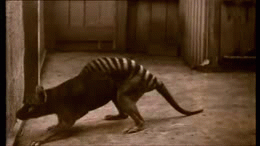Listen....idk What It Is About The Wilfred Batty Photos But They Always Make Me Jump When They Finish


Listen....idk what it is about the Wilfred Batty photos but they always make me jump when they finish and I am left with a thylacine in deep rigor mortis and really good colors.
So...Woolworth female and her joeys and Wilf Batty thylacine photos.


More Posts from Moonlight-wolf-archive and Others

via
There's a lot of angles of the skin we're missing
But I know a Thylacine's stripes are often compared to finger prints
(these are just observations)


1. Highlighted: branches of Benjamin's stripes where they connect to each other within the fur pattern.
Most are connected visibly on the photograph, while the skin only has one major visible branch.
We have witnessed museum specimens losing coloration before so that could be a theory as why the pelt is different if it is Benjamin.
2. Next is these two marks that I can't tell if their stripes or scars that Benjamin had. I don't know if the skin is cut where those marks would be visible or not.
Again just observations ^^

BRUH????

Doggeroo.
The Bristol thylacine looks wistfully out of his glass box.
Sorry for being blurry but I had to use a long exposure on my phone.
This is an awesome book
I definitely recommend it
Sorry if you’ve already said, but what’s the book you’ve been reading about thylacines?


I found this interesting high quality zoomed out version of a iconic thylacine photo







images of the thylacine you have probably never seen before


This thylacine taxidermy at QVMAG has been nicknamed “Frankentiger” because it was constructed from the parts of two different individuals. American taxidermist Frank Tose is pictured in the black and white photograph above constructing Frankentiger’s plaster form in 1937.
Photos are from Where Light Meets Dark. [x]



Brighton Thylacine details, an eye and a front and back foot. This thylacine taxidermy can be found at the Booth Museum, Brighton. (handy reference for artists and model makers.)
Damn I also think of thylacines and laika a bunch. That's nuts.







Angela Gram (American, 1985) - Endling (2022)
-
 seaotter-pop liked this · 1 month ago
seaotter-pop liked this · 1 month ago -
 milo-melon liked this · 10 months ago
milo-melon liked this · 10 months ago -
 olessan liked this · 1 year ago
olessan liked this · 1 year ago -
 gatorboi liked this · 1 year ago
gatorboi liked this · 1 year ago -
 birdbrainedii reblogged this · 1 year ago
birdbrainedii reblogged this · 1 year ago -
 birdbrainedii liked this · 1 year ago
birdbrainedii liked this · 1 year ago -
 graytrailcam reblogged this · 1 year ago
graytrailcam reblogged this · 1 year ago -
 steppetazzie liked this · 1 year ago
steppetazzie liked this · 1 year ago -
 octahedral-chaos liked this · 1 year ago
octahedral-chaos liked this · 1 year ago -
 in-vyn-cible liked this · 1 year ago
in-vyn-cible liked this · 1 year ago -
 everesttherian liked this · 1 year ago
everesttherian liked this · 1 year ago -
 westernstarofthenorth liked this · 1 year ago
westernstarofthenorth liked this · 1 year ago -
 unhingedlesbear liked this · 1 year ago
unhingedlesbear liked this · 1 year ago -
 hero-israel liked this · 1 year ago
hero-israel liked this · 1 year ago -
 tymime liked this · 1 year ago
tymime liked this · 1 year ago -
 stupidgaycuntface liked this · 1 year ago
stupidgaycuntface liked this · 1 year ago -
 khaos-bringer liked this · 1 year ago
khaos-bringer liked this · 1 year ago -
 starrydaemon reblogged this · 1 year ago
starrydaemon reblogged this · 1 year ago -
 cynosuura liked this · 1 year ago
cynosuura liked this · 1 year ago -
 moonlight-wolf-archive reblogged this · 1 year ago
moonlight-wolf-archive reblogged this · 1 year ago

Collection of media revolving around the Thylacine
149 posts